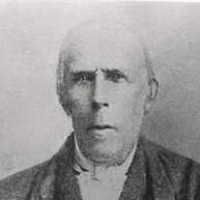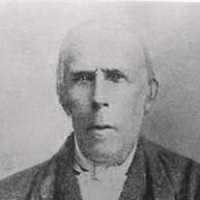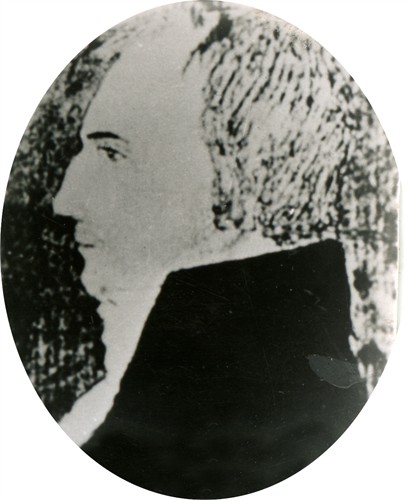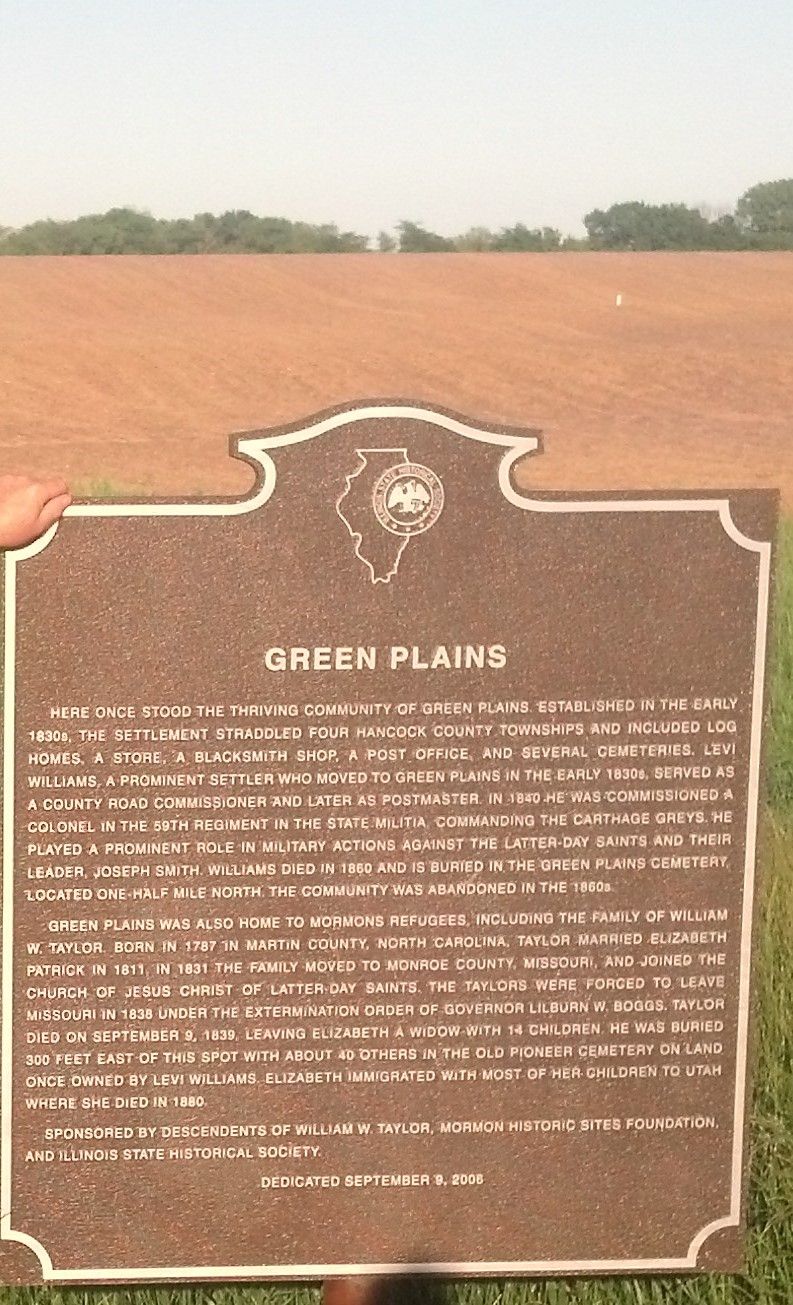Husband of Elizabeth Patrick
Suggested edit: I have written about this before but here goes again. The picture someone posted is James Allred...not William Taylor. William did not die in Warsaw, but near there. There are multiple errors on the marker for his parents, Joseph Taylor & Sarah Best.
Contributor: Ron Taylor (48479378) • [email protected]
Suggested edit: The old history posted from 1933 is riddled with errors. The Taylor Family Association now has much more detailed information about William Taylor and Elizabeth Patrick. Some monuments have even been erected with the same errors on them.
Contributor: Ron Taylor (48479378) •
William did not have a middle name. The picture posted for him is James Allred and has been corrected many times.
Contributor: Ron Taylor (48479378) • [email protected]
By: Lella Marler Hogan
January 1933
William W. Taylor was born in Conetoe, Edgecombe County, North Carolina on 21 Mar 1787. He was the son of Joseph Taylor, whose ancestors had come to America from England as early as 1635, and Sarah Best (Taylor). William had two brothers, Allen and Joseph, and eight sisters ie Elizabeth, Frances, Sarah Best, Lottie, Amy, Temple, Mary Ann, and Delilah.
While William was still a small boy, he came with his parents to Warren County, KY. There, he became a well-informed man and was pronounced in his political views as a Democrat. He married Elizabeth Patrick, daughter of John Patrick and Sarah Kendrick, at Bowling Green, Warren, KY. She bore him fourteen children, seven daughters and seven sons their names as follows: John, Allen, Julia Ann, Mary Ann, Louisa, Elizabeth Ann, Sarah Kendrick Best, Joseph, Pleasant Green, William Warren, Levi, Nancy Jane, Amanda Malvina and James Caldwell.
Their homestead was at Bowling Green until the year 1830. Then they sold their property and pushed out into the West along with other pioneers. They settled in Monroe County, MO, which was a land of wild animals and Indians. This beautiful country was covered with rolling prairies and timberland. William purchased six hundred and forty acres of this valuable land and began the task of converting it into beautiful farmland.
The Church of Jesus Christ was organized in the Spring of 1830. The Saints were constantly persecuted from that time on because of their religious beliefs, being driven from their homes in Missouri and denied the common rights of U.S. citizens. So, in the Spring of 1834, President Joseph Smith formed a military company of one hundred men, known as Zion's Camp and started west to demand that his people in Missouri be given their rights. About two hundred recruits joined the camp en route.
At this time, William Taylor and his family were located on a slight elevation of land between two forks of the Fishing River. When Zion's Camp reached this place, they were forced to stop to mend some of their wagons and to search for some of their horses which had wandered away. Enemies of the church had made threats against the Camp, but before they could be carried out, a furious storm arose. So much rain fell that the river became an impassible torrent. The members of Zion's Camp were forced to take refuge in an old church and in the homes of the Saints nearby. The storm routed the mob who fled in panic. Joseph Smith and his followers remained in the vicinity until the following Sunday, when services were held and the doctrines of the Church expounded. William listened to one sermon and was immediately converted. Before the Camp moved on, he and his wife and his children eight years or older were baptized in the Fishing River. They had been converted too. There were twenty-eight members of the family and friends also who were baptized at that time. William W Taylor was the first person to accept the Gospel and the first man in the State of Missouri to be baptized into the Church. Shortly after this, he was ordained an Elder in the Church and became an earnest preacher of the Gospel.
Two days, after meeting Joseph Smith, William manifested his confidence in the Prophet by fitting up his own son and his son-in-law with provisions, munitions and equipment allowing them to become members of Zion's Camp.
From the time William joined the Church he threw himself into the Lord's work whole-heartedly and followed the Saints through all their persecutions.
He was forced to give up one home after another. His property was stolen and destroyed and insults and injury were heaped upon him and his family, but they never doubted the wisdom of their loyalty to the Faith they had accepted. Trials only held them closer to the Saints with whom they had cast their lot. They owned homes successively in Monroe, Jackson and Caldwell Counties - altogether more than a thousand acres of choice land, but it was all lost to them. William once loaned a man $500.00 in cash but when he went to get the money, the man threatened his life. Another man stole a herd of finely-bred pigs from him, which he never recovered.
William finally settled on Long Creek in Clay County, MO, eight miles south of Farr West. He bought a home and remained there until the Spring of 1839. It was a great joy to him that his family could witness the laying of the cornerstone of the temple at Farr West. Late in the Fall of 1836, to escape mob violence, he moved his family into Farr West. There were so many displaced Saints there that they were unable to find shelter and camped on the ground in the streets. That night, ten inches of snow fell on their blankets. From that time onward, the persecutions became more terrible until, finally, the city was surrendered to the mob. William and his family moved back to Long Creek only to find that the mob had been there and destroyed much of their livestock which had been left behind. Their chickens and pigs had been eaten as well as several heads of cattle and their crops had mostly been burned.
In February 1839, they were again forced to move. Among other things, they had to leave one thousand bushels of corn in the crib, for which they received in return an old neck yoke worth about $2.50.
Finally, Governor Boggs ordered that all the Saints be expelled from the State of Missouri. William accepted his lot patiently and heroically. He and his family traveled hundreds of miles through all kinds of weather. People along the way were unkind to them and added to their discomfort instead of lending sympathy. At last, through exhaustion and exposure, William became ill of Typhoid Fever and on 9 Sep 1839, he passed away. He died as a martyr and was buried on the main road between Lima and Warsaw.
A short time before he died, he called his family around him and counseled them to rally around the Priesthood and to stay with the main body of the Church. Each of his children promised him that they would not marry outside the church.
So ended the life of a great and good man. Through all the years he was resourceful, industrious and progressive. Though he had a strong will he was a humble and God-fearing man. He had great faith and a keen intellect and was absolutely fearless in living according to his convictions. Without hesitation he placed the accumulated wealth of a lifetime on the altar. When he decided to leave everything in order to follow the Saints his relatives clung to him and begged him to remain near them, but there was no turning back for him.
From the day that he answered that first challenge of truth his life was a devotion to the cause that to him was dearer than life itself.
-------------------------
Husband of Elizabeth Patrick
Suggested edit: I have written about this before but here goes again. The picture someone posted is James Allred...not William Taylor. William did not die in Warsaw, but near there. There are multiple errors on the marker for his parents, Joseph Taylor & Sarah Best.
Contributor: Ron Taylor (48479378) • [email protected]
Suggested edit: The old history posted from 1933 is riddled with errors. The Taylor Family Association now has much more detailed information about William Taylor and Elizabeth Patrick. Some monuments have even been erected with the same errors on them.
Contributor: Ron Taylor (48479378) •
William did not have a middle name. The picture posted for him is James Allred and has been corrected many times.
Contributor: Ron Taylor (48479378) • [email protected]
By: Lella Marler Hogan
January 1933
William W. Taylor was born in Conetoe, Edgecombe County, North Carolina on 21 Mar 1787. He was the son of Joseph Taylor, whose ancestors had come to America from England as early as 1635, and Sarah Best (Taylor). William had two brothers, Allen and Joseph, and eight sisters ie Elizabeth, Frances, Sarah Best, Lottie, Amy, Temple, Mary Ann, and Delilah.
While William was still a small boy, he came with his parents to Warren County, KY. There, he became a well-informed man and was pronounced in his political views as a Democrat. He married Elizabeth Patrick, daughter of John Patrick and Sarah Kendrick, at Bowling Green, Warren, KY. She bore him fourteen children, seven daughters and seven sons their names as follows: John, Allen, Julia Ann, Mary Ann, Louisa, Elizabeth Ann, Sarah Kendrick Best, Joseph, Pleasant Green, William Warren, Levi, Nancy Jane, Amanda Malvina and James Caldwell.
Their homestead was at Bowling Green until the year 1830. Then they sold their property and pushed out into the West along with other pioneers. They settled in Monroe County, MO, which was a land of wild animals and Indians. This beautiful country was covered with rolling prairies and timberland. William purchased six hundred and forty acres of this valuable land and began the task of converting it into beautiful farmland.
The Church of Jesus Christ was organized in the Spring of 1830. The Saints were constantly persecuted from that time on because of their religious beliefs, being driven from their homes in Missouri and denied the common rights of U.S. citizens. So, in the Spring of 1834, President Joseph Smith formed a military company of one hundred men, known as Zion's Camp and started west to demand that his people in Missouri be given their rights. About two hundred recruits joined the camp en route.
At this time, William Taylor and his family were located on a slight elevation of land between two forks of the Fishing River. When Zion's Camp reached this place, they were forced to stop to mend some of their wagons and to search for some of their horses which had wandered away. Enemies of the church had made threats against the Camp, but before they could be carried out, a furious storm arose. So much rain fell that the river became an impassible torrent. The members of Zion's Camp were forced to take refuge in an old church and in the homes of the Saints nearby. The storm routed the mob who fled in panic. Joseph Smith and his followers remained in the vicinity until the following Sunday, when services were held and the doctrines of the Church expounded. William listened to one sermon and was immediately converted. Before the Camp moved on, he and his wife and his children eight years or older were baptized in the Fishing River. They had been converted too. There were twenty-eight members of the family and friends also who were baptized at that time. William W Taylor was the first person to accept the Gospel and the first man in the State of Missouri to be baptized into the Church. Shortly after this, he was ordained an Elder in the Church and became an earnest preacher of the Gospel.
Two days, after meeting Joseph Smith, William manifested his confidence in the Prophet by fitting up his own son and his son-in-law with provisions, munitions and equipment allowing them to become members of Zion's Camp.
From the time William joined the Church he threw himself into the Lord's work whole-heartedly and followed the Saints through all their persecutions.
He was forced to give up one home after another. His property was stolen and destroyed and insults and injury were heaped upon him and his family, but they never doubted the wisdom of their loyalty to the Faith they had accepted. Trials only held them closer to the Saints with whom they had cast their lot. They owned homes successively in Monroe, Jackson and Caldwell Counties - altogether more than a thousand acres of choice land, but it was all lost to them. William once loaned a man $500.00 in cash but when he went to get the money, the man threatened his life. Another man stole a herd of finely-bred pigs from him, which he never recovered.
William finally settled on Long Creek in Clay County, MO, eight miles south of Farr West. He bought a home and remained there until the Spring of 1839. It was a great joy to him that his family could witness the laying of the cornerstone of the temple at Farr West. Late in the Fall of 1836, to escape mob violence, he moved his family into Farr West. There were so many displaced Saints there that they were unable to find shelter and camped on the ground in the streets. That night, ten inches of snow fell on their blankets. From that time onward, the persecutions became more terrible until, finally, the city was surrendered to the mob. William and his family moved back to Long Creek only to find that the mob had been there and destroyed much of their livestock which had been left behind. Their chickens and pigs had been eaten as well as several heads of cattle and their crops had mostly been burned.
In February 1839, they were again forced to move. Among other things, they had to leave one thousand bushels of corn in the crib, for which they received in return an old neck yoke worth about $2.50.
Finally, Governor Boggs ordered that all the Saints be expelled from the State of Missouri. William accepted his lot patiently and heroically. He and his family traveled hundreds of miles through all kinds of weather. People along the way were unkind to them and added to their discomfort instead of lending sympathy. At last, through exhaustion and exposure, William became ill of Typhoid Fever and on 9 Sep 1839, he passed away. He died as a martyr and was buried on the main road between Lima and Warsaw.
A short time before he died, he called his family around him and counseled them to rally around the Priesthood and to stay with the main body of the Church. Each of his children promised him that they would not marry outside the church.
So ended the life of a great and good man. Through all the years he was resourceful, industrious and progressive. Though he had a strong will he was a humble and God-fearing man. He had great faith and a keen intellect and was absolutely fearless in living according to his convictions. Without hesitation he placed the accumulated wealth of a lifetime on the altar. When he decided to leave everything in order to follow the Saints his relatives clung to him and begged him to remain near them, but there was no turning back for him.
From the day that he answered that first challenge of truth his life was a devotion to the cause that to him was dearer than life itself.
-------------------------
Family Members
-
![]()
Frances Taylor Cherry
1783–1852
-
![]()
Amy Taylor Wallace
1784–1865
-
![]()
Delilah Taylor Wallace
1786–1853
-
![]()
Allen Taylor
1789–1878
-
Mary Ann Taylor Upton
1791–1852
-
![]()
Seraphy Temperance "Tempy" Taylor Smart
1793–1843
-
![]()
Nancy Taylor
1797–1812
-
Sarah Best Taylor Hudnall
1800–1837
-
![]()
Joseph Best Taylor
1801–1864
-
![]()
Elizabeth Ann Taylor Goode
1803–1861
-
![]()
Charlotte "Lottie" Taylor White
1805–1867
-
![]()
John Taylor
1812–1896
-
![]()
Allen Taylor
1814–1891
-
![]()
Julia Ann Taylor Allred
1816–1898
-
Mary Ann Taylor McCord
1818–1842
-
![]()
Louisa Taylor Stout
1819–1853
-
![]()
Elizabeth Ann Taylor Criddle
1821–1906
-
![]()
Sarah Kendrick Best Taylor Dobson
1823–1909
-
![]()
Pvt Joseph Taylor
1825–1900
-
![]()
Pleasant Green Taylor
1827–1917
-
![]()
William Warren Taylor Jr
1828–1892
-
![]()
Levi Taylor
1830–1909
-
![]()
Nancy Jane Taylor Smith
1833–1900
-
![]()
Amanda Malvina Taylor
1835–1845
-
![]()
James Caldwell Taylor
1837–1907
Advertisement
Records on Ancestry
Sponsored by Ancestry
Advertisement





























